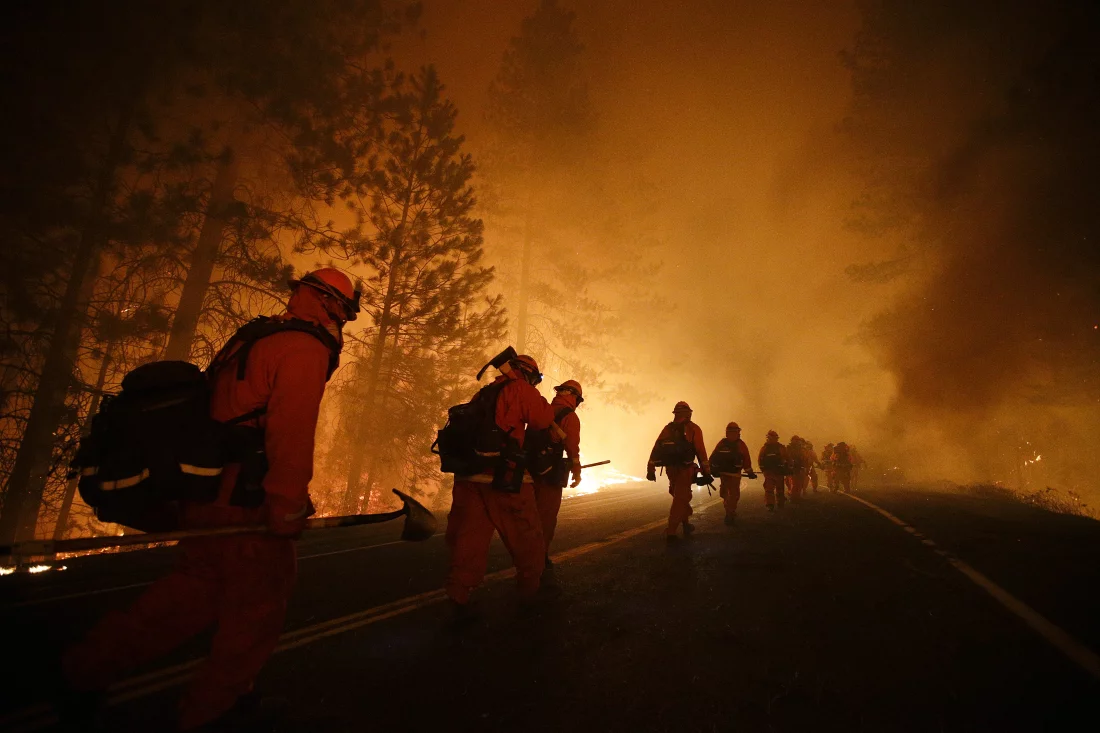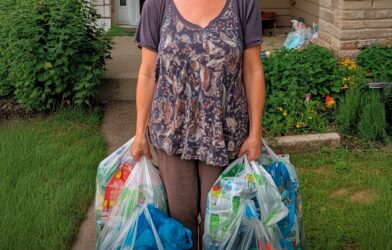
Inmate firefighters walk along Highway 120 during the Rim Fire near Yosemite National Park, Calif. in 2013. California currently has about 400 inmate firefighters battling the LA county wildfires.
Jae C. Hong/AP
More than 900 incarcerated people are among the more than 7,500 personnel helping fight the historic, and destructive, Southern California wildfires.
The five raging wildfires have destroyed homes, businesses and landmarks throughout Los Angeles.
“As of today, 939 Fire Camp firefighters have been working around the clock cutting fire lines and removing fuel from behind structures to slow fire spread, including 110 support staff.,” California’s Department of Corrections and Rehabilitation said in a statement to NPR on Friday.
This is not a new practice. California has relied on incarcerated firefighters since 1915. And prison labor has been used to respond to emergencies and disasters nationwide for centuries, said Bianca Tylek, executive director of Worth Rises, a criminal justice advocacy organization.
To those, like Tylek, opposed to the continued use of inmates as firefighters, the system is seen as exploitative.
California’s department of corrections says individuals who are part of this program are there voluntarily and are paid between $5.80 and $10.24 per day, with additional pay provided during emergencies and in other circumstances.
This controversial practice also fills critical personnel gaps, especially as California faces a future with longer and more destructive fire seasons due to climate change. During the first full day of the wildfires, LA area-crews were battling upwards of five large blazes at the same time, which stretched the county’s emergency response resources and staff, Anthony Marrone, LA County fire chief, said Wednesday.

Inmate firefighters from the California Department of Corrections and Rehabilitation walk in at the Station Fire Incident Command Post in the Lake View Terrace area of Los Angeles in 2009.
Jae C. Hong/AP/AP
‘Do they completely choose what they do?’
California is one of more than a dozen states that operates conservation camps, commonly known as fire camps, for incarcerated people to train to fight fires and respond to other disasters.
The program was first established in 1915, but expanded during World War II after forestry staff left to fight in the war. In the interim, incarcerated people were tapped as replacements and 41 camps were established. There are now 35 such camps in California, all of which are minimum-security facilities.
These fire-fighting crews are made up of incarcerated volunteers deemed physically and mentally fit, who have exhibited good behavior and follow the rules, according to CDCR. They must also have eight years or less remaining on their sentence. When they are not fighting fires, they also respond to floods and other disasters and emergencies. Otherwise, the crews do community service work in areas close to their camp, according to the state corrections department.
Tylek, of Worth Rises, questions how voluntary the assignment are given that California’s corrections department, like many prisons across the country, requires inmates to work. Prison labor programs, generally, have historical ties to the end of the Civil War and the passage of the 13th Amendment, which abolished slavery “except as a punishment for crime” — an exception that prison rights advocates like Tylek say allows for exploitative labor.
She acknowledged some individuals do want to work for the firefighting program. And there are many who have found a calling in the work.
“But it comes at a pretty steep cost,” Tylek said noting that she’s heard from people badly injured while doing this work at a very low wage.
A 2018 Time investigation found that incarcerated firefighters are at a higher risk for serious injuries. They also are more than four times as likely to get cuts, bruises or broken bones compared to professional firefighters working the same fires, the report found. They were also more than eight times as likely to face injuries after inhaling smoke, ash and other debris compared with other firefighters, the report said.
California’s corrections department said incarcerated people do not face disciplinary action if they choose not to serve their time in a fire camp. The inmates also undergo safety and first-aid training as part of the program.

A firefighter waters down a home after the Eaton Fire burns in Altadena, Calif., Thursday, Jan. 9, 2025.
Nic Coury/AP/AP
There have been efforts to stop prison labor
While most inmates receive little to no pay “nationwide, incarcerated workers produce more than $2 billion a year in goods and commodities and over $9 billion a year in services for the maintenance of the prisons where they are warehoused,” a 2022 joint report from the ACLU and The University of Chicago’s Global Human Rights Clinic found.
Since 2018, the year in which Colorado banned the use of unpaid prison labor, a movement emerged calling on states to change their constitutions to remove the 13th Amendment “exception.” An NPR investigation found that even in states that approved this change, prisoners were still being used for low or unpaid labor.
In 2024, California and Nevada brought the question of banning the practice of using prisoners as unpaid labor to voters. Nevada’s voters approved the ban while California voters rejected Proposition 6.
Tylek said changing voters’ mind on this issue “is an ongoing effort.”
The ongoing Southern California wildfires “really illustrates why that effort was so important,” she said. As hundreds of “incarcerated people take to the front lines of these wildfires to defend the personhood and property of people around the Los Angeles area and California, I hope that Californians can start to realize their value.”











